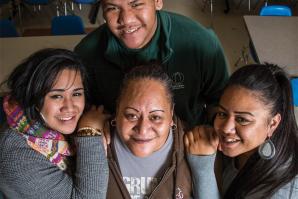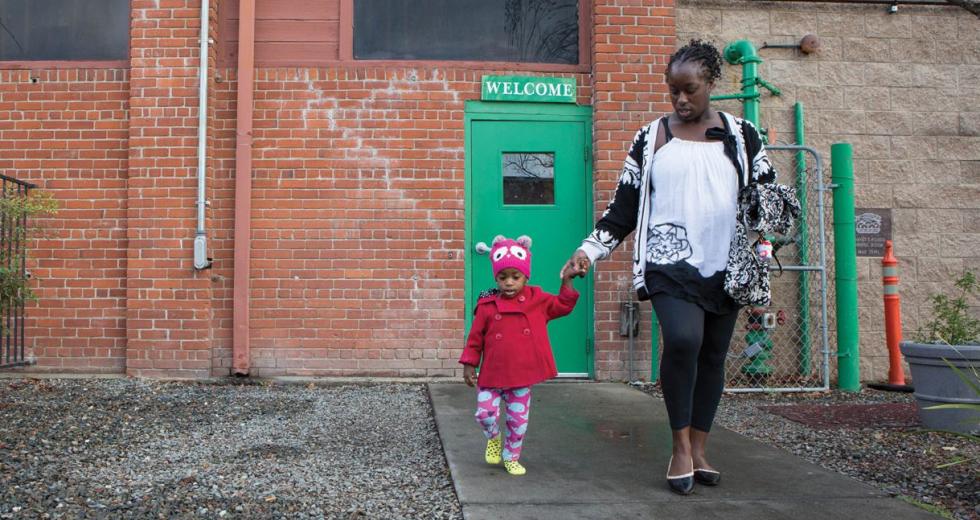There is good news and bad news on the homelessness front. Despite a slight uptick between 2011 and 2013, overall homelessness in Sacramento County is on the decline. Yet, according to the most recent data, one of the most vulnerable demographics — homeless women and children — is rising steadily. Though a new rapid rehousing initiative may stymy the troubling trend locally, some providers remain concerned that a lack of mandatory supportive services and intensive case management may cause the program to exacerbate, not eliminate, the problem.
According to the most recent point-in-time homeless count, a one-day, volunteer-driven count of sheltered and unsheltered persons led by Sacramento Steps Forward, overall homelessness in the county has decreased by more than 9 percent since 2009. During that same period, the number of homeless families has steadily increased by almost 50 percent. According to the 2010 Annual Homeless Assessment Report to Congress, single mothers head the majority of homeless families.
But these families are hard to track. Based on anecdotal evidence, single mothers and their children have an easier time garnering sympathy from friends and family, so they’re able to couch surf between stints at shelters, motels or on the street. Though hardly a stable living situation, it means they are frequently missing from point-in-time data like street counts.
“People don’t realize there are children sleeping by the river, in garages and outside,” says Cynthia Torres, the co-director of Maryhouse, a facility that serves single women and families during daytime hours. “We try to link them to services, but sometimes I can’t find a shelter bed for a child. Every day families are turned away.”
Michele Watts, the interim deputy director for Sacramento Steps Forward, points out that, while the number of homeless families is undoubtedly increasing, recent changes in transitional housing capacity are also skewing the numbers. A transitional housing program opened in Sacramento County in 2011, creating 105 beds for families — families that may not have been visible in years prior.
In the war against homelessness, assisting families hasn’t traditionally been a priority. The federal government’s 10 Year Plan to End Homelessness started in earnest in 2002 under former President George W. Bush and primarily funded initiatives that addressed the chronically homeless, defined as single adults with disabilities. That population makes up less than one-third of the overall homeless population but consumes more than half of the resources.
“The women and children that we see need a lot more than a house to get them back on their feet.”
Michele Steeb, executive director, St. John’s Shelter for Women and Children
In 2011, the federal government expanded the definition of the chronically homeless to include families. The federal Department of Housing and Urban Development’s Homeless Emergency and Rapid Transition to Housing Act will now provide funding for rapid rehousing, a program that identifies singles and families in emergency shelters and, as quickly as possible, places them in permanent housing with financial aid.
Watts says rapid rehousing worked well in its initial run in Sacramento County from 2009 to 2011. Funded in part by the American Recovery and Reinvestment Act, the $11 million program served 2,401 households consisting of roughly 6,100 individuals. Six months after exiting the program, 98 percent of assisted families remained in stable housing.
“Ideally, we’re sort of routing off all of these folks who were taking up emergency shelter beds to a rapid rehousing program,” says Watts, “and then the emergency shelter can focus on serving those with higher needs. The system just works better.”
Perhaps. Homeless families increased a whopping 33 percent between 2011 and 2013. But during the period of time that rapid rehousing was used, the increase was just 11 percent. It remains unclear how much of a role recidivism played in the jump following the end of the program. Compared to temporary transitional housing, rapid rehousing provides what is intended to be a permanent home supplemented by financial assistance and some case management, which is reduced over time as an individual or family becomes self-sustaining. It does not require — though ideally provides — access to additional supportive services such as job training, substance abuse counseling and mental health care.
“For a certain segment of the homeless population, I think rapid rehousing is a good approach,” says Michele Steeb, executive director of the St. John’s Shelter for Women and Children. St. John’s offers shelter and permanent supportive housing for women and their children alongside employment training, counseling and other supportive services such as transportation and childcare. “The problem is that not every person is alike, and the women and children that we see need a lot more than a house to get them back on their feet.”
Single mothers find themselves in great need of supportive services. According to Women’s Empowerment fund developer Kate Towson, 80 percent to 90 percent of the women served through the nonprofit’s wellness and job training program have survived domestic violence, 75 percent experienced childhood abuse and up to 70 percent have a mental illness.
Additionally, since 2007 California has seen a nearly 40-percent cut in funding for childcare and preschool. According to the California Budget Project, a single parent working full-time at the state’s minimum wage would spend nearly half of his or her income on child care. Add that to the steady increase (almost 8 percent since 2007) of unemployment in single mothers and a median wage for single moms that’s at its lowest since the mid-90s. The Department of Housing and Urban Development used to provide some funding for child care, job training and mental health services, but starting this year that money will pay for housing only.
In addition to an individual’s motivation to use supportive services (should they be available), the success of a rapid rehousing program can hinge on a community’s continuum of care. Broadly defined, the continuum includes all community resources, public and private, directed toward addressing and preventing homelessness. A well-sourced continuum ideally offers an array of services and targeted points of entry, so that all homeless individuals enter the system in designated, coordinated locations and are given a comprehensive assessment before being directed to applicable resources. Imagine a young mother and two children who spend six weeks at an emergency shelter only to later end up in a rapid rehousing program. Those six weeks in the shelter weren’t necessary, and the beds occupied by the family could have gone to others for whom emergency shelter was necessary.
The program has worked exceptionally well in some communities. Alameda County’s rapid rehousing project was facilitated by coordinating nonprofit Everyone Home. Already focused on building partnerships with providers throughout the county, Everyone Home set up seven housing resource centers as points of entry and worked closely with the Alameda County Social Services Agency, which facilitates temporary assistance and child welfare services. This collaboration not only ensured that funding was used efficiently, it also linked families to necessary services.
According to the National Alliance to End Homelessness, “The housing center staff also became more knowledgeable about other … resources for low-income families, including income and work supports such as child care and transportation assistance. This allowed them to help their own clients become better informed about the array of resources they were eligible to receive from Alameda County Social Services.”
After launching its program in 2007, Alameda County saw a
26-percent drop in sheltered families and a 70-percent decrease
in unsheltered homeless families. Only 3 percent of those who
benefited from rapid rehousing returned to a shelter within 12
months.
Compare those stats to New York City’s rapid rehousing programs,
which failed due to a lack of wrap-around services. The first
program, Housing Stability Plus, offered families a subsidy,
which decreased by 20 percent each year with the intention of
transitioning occupants into self-sustainability. Three years
into what was to be a 5-year program, HSP was cut short and
replaced with the Work Advantage Program. WAP offered qualified
working families a 100-percent rent subsidy in return for a
symbolic $50 contribution. After two years, the subsidy was cut
off and the full burden of rent fell onto families.
In the 2005 fiscal year, 26 percent of New York City’s homeless families exited and then returned to the shelter system. By the 2009 fiscal year, 40 percent of assisted families boomeranged out of and back into the shelter system. A large part of the problem, according to Dona Anderson, director of the Institute for Children, Poverty and Homelessness, is that NYC’s continuum of care focuses on singles.
“There are access barriers in New York in trying to get from point A to point B,” Anderson says. “Services are available, however what shelter providers don’t have is a mechanism to continue to help families after they move out of the shelter.”
New York City also lacks a collaborative, organized system of entry and assessment. According to Anderson, the city needs “a common assessment and intake system amongst all providers, identifying a family’s characteristics and the wrap-around services they need.”
A new rapid rehousing program is set to launch in Sacramento County this month. While at the time of publication a provider had yet to be determined, SHRA program manager Geoffrey Ross says that coordinated entry and links to wrap-around services are top priorities. Though at this point there is no funding for a coordinated entry system, Watts says Sacramento Steps Forward has a plan in place once funding is available.
“Wrap-around services, including case management, are still being looked at as part of this program,” Ross says. “All of our providers are part of the continuum of care, and they all try to provide these services through their stand-alone programs. We would be looking to do the same thing here.”
While funding for the upcoming program is small compared to the previous program ($800,000 in the first year and $200,000 for each following year), Ross says the goal is to serve 180 families in the first year.
Yet some, like Steeb and her team, remain skeptical that any program that doesn’t include required sobriety and cooperation with case management will work.
“It’s like putting a band-aid on a bullet wound,” says Ronita Iulio, a graduate of St. John’s who now works in the organization’s career center. “It just takes eyesores off of the streets and puts them under a roof. If there are no guidelines for them to meet, it’s never going to work.”
Recommended For You

From Setbacks to Scholar
St. John’s Shelter Program offers women a fresh start
A twice-convicted felon, Ronita Iulio thought she had blown her last chance to salvage her life and family. After being released from prison in 2008, Iulio was anxious to reunite with her three children, but instead she faced an unsympathetic court that granted full custody to her ex-husband.




